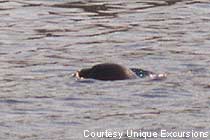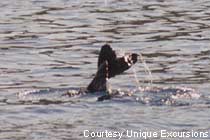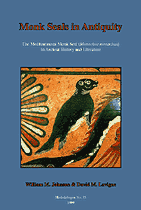

 |
||
 |
||
Vol. 6 (1): June 2003 |
Download this page
|
|
Monk seal parasiteI am wondering if you have heard that Toxoplasma gondii, a parasite carried by domestic cats, has been found in Hawaiian monk seals. Toxoplasmosis has been implicated in the decline of southern sea otters off California, but I have not heard of it in relation to Hawaiian monk seals. However, I have received an inquiry – I was hoping you could clarify the situation. Naomi A. Rose, Ph.D., Marine Mammal Scientist, Wildlife and Habitat Protection, The Humane Society of the United States.
Toxoplasma gondii is a single-celled protozoan that can infect many if not most mammals. The work by Melissa Miller with Toxoplasma and sea otters in California is well known to us. We also understand that the disease has been found in several free ranging wild dolphin species as well as many terrestrial mammals. It is also well known that Toxoplasma can be transmitted by a number of known and unknown vectors including cats, rodents, and birds. In regard to wild Hawaiian monk seals, we have had an ongoing epidemiological survey for a number of potential diseases (including Toxoplasma) since 1998. We have also done necropsies and histopathology on almost every monk seal carcass recovered since the early 1980s. Thus, Toxoplasma has been evaluated as a potential pathogen as part of our routine epidemiological investigations. Serological testing, using the modified agglutination test (MAT) at the National Veterinary Disease Laboratory in Ames, Iowa; has only resulted in two positives from a sample size of more than ten percent of the population. Both were low titers, indicating possible exposure to Toxoplasma gondii or other cross reacting antigen(s). The samples were collected from two females that have been observed for five years subsequent to sampling and no apparent clinical or reproductive signs of abnormality have been detected. One female has given birth each year since 1990 and the other has given birth each year except one since 1998. Both females were observed during the 2002 field season and appeared to be normal and healthy. Judging from the condition and reproductive success of these females, we do not consider the low titer values to be indicative of disease. Both females will be carefully observed again during this field season. Finally, our ongoing histological and necropsy evaluations have on a few occasions identified another protozoan called Sarcocystis, but we have not found Toxoplasma or pathology associated with it. We have considered the threat of toxoplasmosis to the monk seal population and we will continue to survey Hawaiian monk seals for this potential pathogen. Fortunately, we have found no significant evidence of disease from this potential pathogen in any of the subpopulations.
|
 |
 |
We have just had a very good sighting of a monk seal here in our area. We sighted the seal at 15.45 on 8th of May. The location was close to Nidri on the Island of Levkas [Lefkada, Ionian Sea], Greece. I wish to log the sighting and attach two photos taken by one of our clients. Our company is Unique Excursions and we run marine tours teaching people about the local marine life in the area.
I hope you can use the sighting for your records.
Steve Clarke-lens, Unique Excursions, Lefkas, Greece.
I am a professor of Classics at Freiburg in Germany and I am working on a commentary on Aristotle’s book De partibus animalium. Aristotle gives very good information about Monachus monachus, but also makes one observation which is doubtful. He claims that this seal does not possess a gall-bladder.
Could you tell me whether this is correct or not?
Prof. Dr. Wolfgang Kullmann, Freiburg, Germany.
![]() Editor’s reply: Aristotle’s observations of monk seal behaviour and anatomy were generally accurate. However, he erred in describing the monk seal as having 2 rather than 4 teats, and in reporting that the seal does not possess a gall bladder.* The latter error is somewhat mystifying, particularly since there is reason to believe that Aristotle studied monk seal anatomy on the dissection table, and that (at least according to later writers), seal gall was a valued commodity in medicine.**
Editor’s reply: Aristotle’s observations of monk seal behaviour and anatomy were generally accurate. However, he erred in describing the monk seal as having 2 rather than 4 teats, and in reporting that the seal does not possess a gall bladder.* The latter error is somewhat mystifying, particularly since there is reason to believe that Aristotle studied monk seal anatomy on the dissection table, and that (at least according to later writers), seal gall was a valued commodity in medicine.**
For a reference on the presence of a gall bladder in the seal, consult (page 171, under “Liver”): King, Judith. 1983. Seals of the World. British Museum (Natural History) & Oxford University Press, London & Oxford: 1-240.
For further information on monk seals and their role in the history, culture and economy of the ancient world:
 |
Johnson, W.M., & D.M. Lavigne. 1999. Monk seals in Antiquity. The Mediterranean monk seal (Monachus monachus) in ancient history and literature. Mededelingen 35: 1-101. The Netherlands Commission for International Nature Protection. Publisher’s information on the title is available at: http://www.euronet.nl/users/backhuys/boekmonk.htm. View abstract. |
* “There is no gall-bladder in the seal, nor (among sea-animals) in the dolphin” (On the Parts of Animals, 676b, 28-29).
* “Some animals have, and some have not, a gall-bladder up against the liver. The deer is an example of a viviparous quadruped which has none: other examples are the roe, the horse, the mule, the ass, the seal, and some kinds of pig” (Historia Animalium, 506a, 21-25).
** “The seal... gets rid of its gall, which is useful for many drugs, by vomiting it up, and also its rennet, a cure for epileptic attacks; it does this because it knows that it is hunted for the sake of these products” (Pliny, Natural History, VIII.111).
The editor reserves the right to edit letters for the sake of clarity and space
Copyright © 2003 The Monachus Guardian. All Rights Reserved |